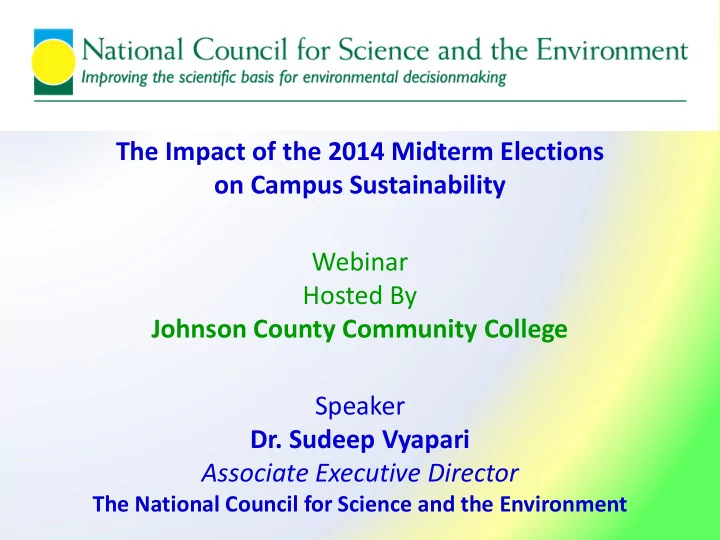

The Impact of the 2014 Midterm Elections on Campus Sustainability Webinar Hosted By Johnson County Community College Speaker Dr. Sudeep Vyapari Associate Executive Director The National Council for Science and the Environment
The Federal Budget Process The Federal Budget is Kind Of a Big Deal “Politics is who gets what, when, and how.” - Harold Lasswell “Budgeting is about values, and it’s about choices.” – Rep. Rosa DeLauro Put another way: budgeting is a manifestation of politics Negotiation between competing interests (and their proxies) in a decentralized system Major impact for R&D and innovation: most basic research, and most university research, is federally funded Data and Original Presentation Source: Matt Hourihan, Director of the R&D Budget and Policy Program, AAAS
Data and Original Presentation Source: Matt Hourihan, Director of the R&D Budget and Policy Program, AAAS
Data and Original Presentation Source: Matt Hourihan, Director of the R&D Budget and Policy Program, AAAS
Data and Original Presentation Source: Matt Hourihan, Director of the R&D Budget and Policy Program, AAAS
Data and Original Presentation Source: Matt Hourihan, Director of the R&D Budget and Policy Program, AAAS
Spending: Two Spending Categories: Discretionary vs. Mandatory Mandatory Spending (aka Direct Spending) Mostly entitlements, mostly on “autopilot” Potential for high political sensitivity = “third rail” Discretionary Spending: Adjusted annually Easy (nondefense) targets? i.e. Sequestration Vast majority of federal R&D is discretionary Data and Original Presentation Source: Matt Hourihan, Director of the R&D Budget and Policy Program, AAAS
Budget Process: A Typical Federal Budget Process: Three Years, Four Phases Budget Release Phase 1: Planning within Agency w/ OMB and Phase 2: OMB Phase 3: Congressional OSTP oversight Review budget and appropriations Oct Nov Dec Jan Feb Mar Apr May Jun Jul Aug Sep Oct Nov Dec Jan Feb Mar Apr May Jun Jul Aug Sep Phase 4: Execute the fiscal year’s budget (not shown) Arranged by fiscal year (Oct ober t o S ept ember) Data and Original Presentation Source: Matt Hourihan, Director of the R&D Budget and Policy Program, AAAS
President’s R&D Budget: What Drives Presidential R&D Budget Formulation? Top-down and bottom-up priorities and politics OMB oversight and OSTP input Technical and political judgment Expert and community input Congressional legislation Big (fiscal) picture Incrementalism Data and Original Presentation Source: Matt Hourihan, Director of the R&D Budget and Policy Program, AAAS
Budget Process: Budget Release Phase 1: Planning within Agency w/ OMB and Phase 2: OMB Phase 3: Congressional OSTP oversight Review budget and appropriations Oct Nov Dec Jan Feb Mar Apr May Jun Jul Aug Sep Oct Nov Dec Jan Feb Mar Apr May Jun Jul Aug Sep Phase 1: Internal agency discussions and planning Strategic plans, staff retreats, program assessments More bottom-up than top down OMB is present throughout Early spring: guidance memo Science & Tech: Joint guidance memo from OMB / OSTP (midsummer) Agencies deliver budget justifications to OMB (early fall) Data and Original Presentation Source: Matt Hourihan, Director of the R&D Budget and Policy Program, AAAS
Not-for-profit organization dedicated to improving the scientific basis of environmental decision-making . It seeks to be a bridge that spans the divide between science, its applications, and policy . NCSE specializes in programs that foster collaboration between the diverse institutions and individuals creating and using environmental knowledge to make science useful to policies and decisions on critical environmental issues. 25 th Year celebration in 2015 Over 200 Institutions of Higher Education Affiliate Members
Community College Affiliate Program (CCAP) founded in June 2013 (6 Founding Members) January 2014 to Date: Membership grew from 12 – nearly 30 First of its kind Census of Community Colleges on Interdisciplinary Environment Sustainability (IES) Education Report published in June 2014. Second phase of research in progress. CCAP Elected its inaugural CCAP Executive Committee in October 2014 CCAP and CEDD (2- and 4-year colleges) working together on many initiatives and issues of common concern . Some issues being addressed are: Curriculum, Gateway courses, Career Pathways, Workforce / Training, Credit vs. Non-Credit Programs, Diversity, STEAM, and Professional Development for Faculty
Thank You! Dr. Sudeep Vyapari Associate Executive Director The National Council for Science and the Environment svyapari@ncseonline.org www.ncseonline.org (202) 207-0007
Recommend
More recommend